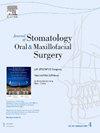自由皮瓣重建口腔后立即口服喂养。
IF 2
3区 医学
Q2 DENTISTRY, ORAL SURGERY & MEDICINE
Journal of Stomatology Oral and Maxillofacial Surgery
Pub Date : 2024-12-10
DOI:10.1016/j.jormas.2024.102196
引用次数: 0
摘要
目的:对于头颈部手术后早期口服喂养的定义和价值尚无共识。本研究的主要目的是确定自由瓣口腔重建后2天内立即口服软饮食(IOF)对30天内严重术后发病率和住院时间(LoS)的影响。方法:于2021-2023年在我院三级医院中心进行回顾性队列研究。采用多变量回归分析术后严重并发症与LoS与IOF自变量的关系。我们还研究了与延迟口服喂养(DOF)相关的因素;术后10天内缺乏口服喂养。调整的混杂变量为人口统计学相关(年龄、性别)、合并症相关(ASA评分、营养不良、既往病史)和手术相关(物质丢失类型/位置、皮瓣类型)。结果:纳入132例患者:术后≥3天口服喂养的IOF患者n=29/132(22%)和口服喂养患者n=103/132(78%)。与术后≥3天口服喂养相比,IOF与术后30天内严重并发症发生率降低(AOR为0.3[0.1-0.8],p=0.01)和住院时间缩短(AEE为-6.7 [-11.8- 1.6],p=0.01)独立相关。DOF与心血管病史呈正相关(AOR为2.7[1.1 ~ 7.3],p=0.04),与头颈部手术合并放疗史呈负相关(AOR为0.4[0.1 ~ 0.8],p=0.05)。结论:术后口服喂养方案应考虑IOF。为外科医生更广泛地实施IOF,需要进一步定义IOF的合适候选者的标准。本文章由计算机程序翻译,如有差异,请以英文原文为准。
Immediate oral feeding after free-flap reconstruction of the oral cavity
Aim
There remains no consensus on the definition or value of early oral feeding after head and neck surgery. The main objective of this study was to determine how immediate oral feeding (IOF) with soft diet within 2 days following free-flap reconstruction of the oral cavity affected severe post-operative morbidity within 30 days and length of hospital stay (LoS).
Methods
A retrospective cohort study was carried out in 2021–2023 in our tertiary hospital center. The associations between severe post-operative morbidity and LoS with the independent variable of IOF were analyzed by multivariate regression analysis. We also examined the factors associated with delayed oral feeding (DOF); lack of oral feeding within 10 post-operative days. The confounding variables adjusted for were demographic-related (age, sex), comorbidity-related (ASA score, undernutrition, prior history), and surgery-related (substance loss type/location, flap type).
Results
Inclusion was 132 patients: n = 29/132 (22 %) IOF patients versus n = 103/132 (78 %) patients undergoing oral feeding after ≥3 post-operative days. IOF was found independently associated with reduced severe post-operative morbidity within 30 days (AOR 0.3[0.1–0.8], p = 0.01) and shorter length of stay (AEE -6.7 [-11.8–-1.6], p = 0.01) compared to oral feeding after ≥3 post-operative days. DOF was found positively associated with cardiovascular history (AOR 2.7[1.1–7.3], p = 0.04) but negatively associated with a history of head and neck surgery with radiotherapy (AOR 0.4[0.1–0.8], p = 0.05).
Conclusion
Protocols for post-operative oral feeding should consider IOF. Criteria for good candidates for IOF require further definition for surgeons to implement IOF more widely.
求助全文
通过发布文献求助,成功后即可免费获取论文全文。
去求助
来源期刊

Journal of Stomatology Oral and Maxillofacial Surgery
Surgery, Dentistry, Oral Surgery and Medicine, Otorhinolaryngology and Facial Plastic Surgery
CiteScore
2.30
自引率
9.10%
发文量
0
审稿时长
23 days
 求助内容:
求助内容: 应助结果提醒方式:
应助结果提醒方式:


